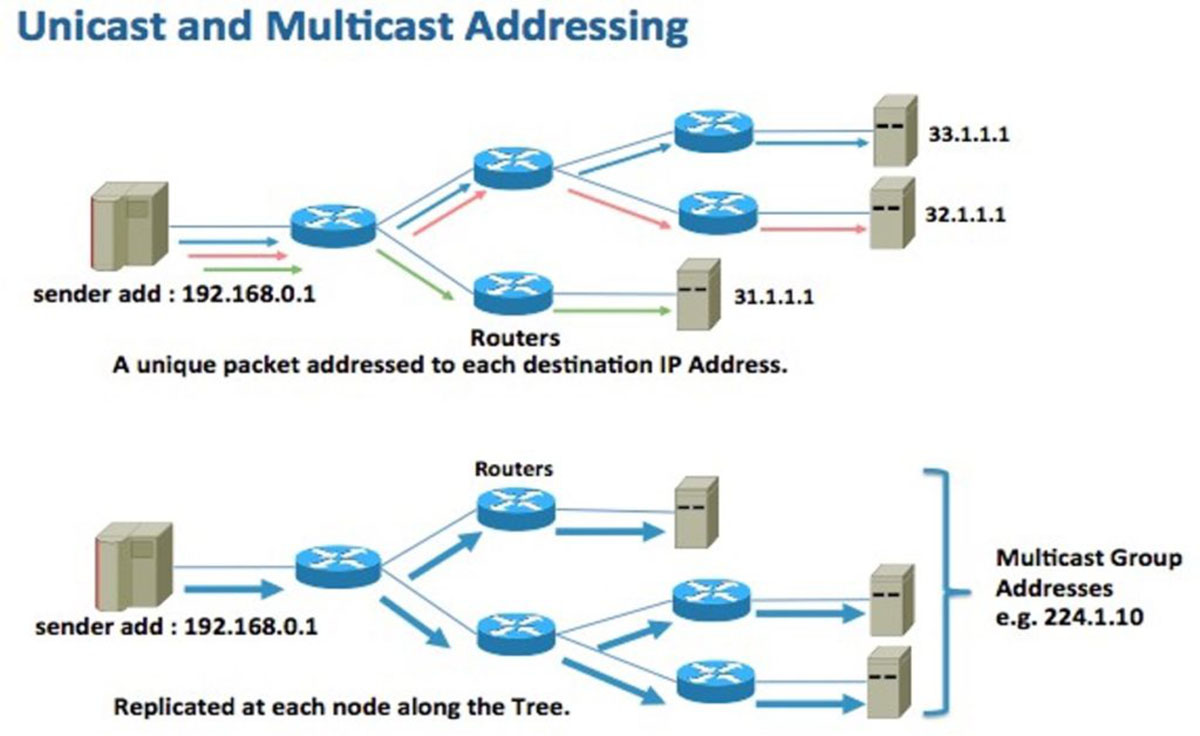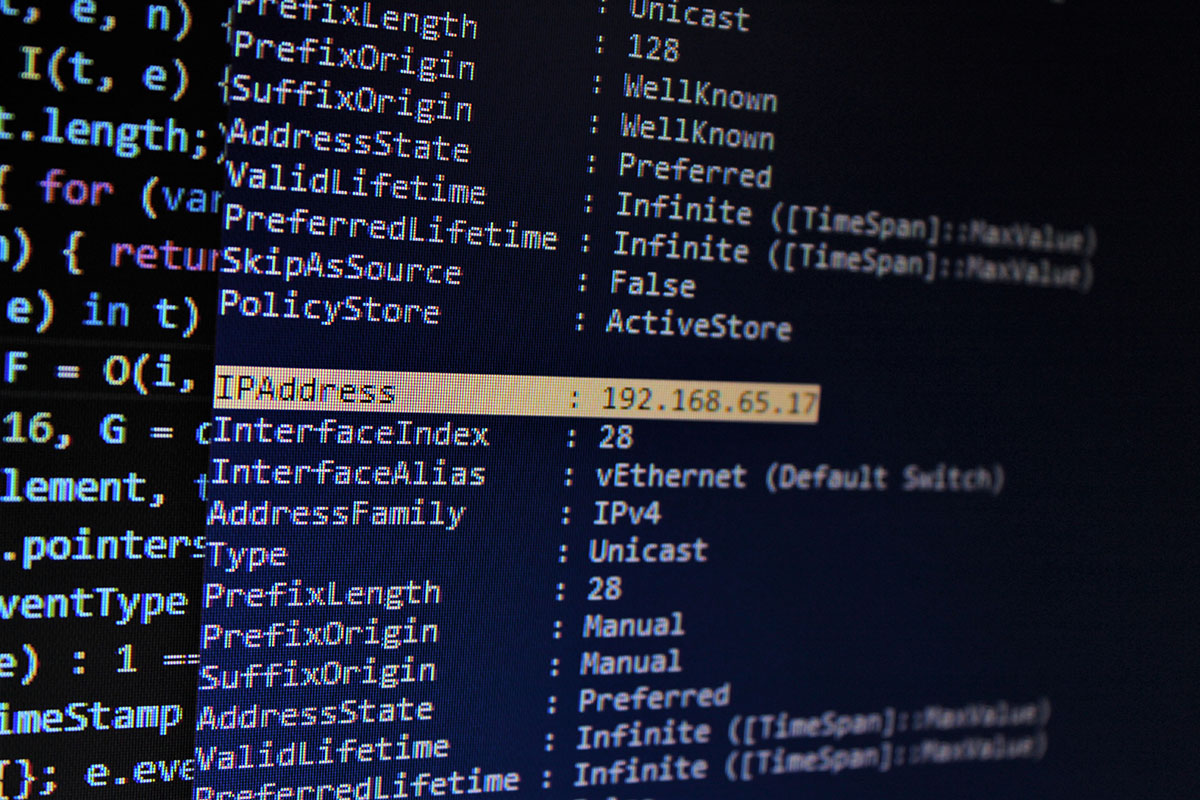Introduction
The internet has revolutionized the way we communicate and share information. From email to video streaming, there are countless applications that rely on efficient data transmission. One such method is the use of multicast IP addresses. But what exactly is a multicast IP address and how does it improve data transmission efficiency? In this article, we will delve into the functionality of multicast IP addresses and explore their role in modern networking.
Multicast IP address refers to a specific type of IP address that allows for data transmission from one sender to multiple recipients simultaneously. While unicast addresses are used for one-to-one communication and broadcast addresses for one-to-all communication, multicast addresses are designed for one-to-many communication. This means that a single data packet can be sent to a group of recipients, reducing network congestion and improving efficiency.
At the heart of multicast IP address functionality is the concept of group communication. In traditional unicast communication, the sender transmits a separate copy of the data packet to each recipient, resulting in unnecessary duplication of network resources. Multicasting eliminates this duplication by allowing the sender to rely on the network infrastructure to replicate and distribute the data packet to all members of the multicast group.
The way multicast IP addresses work can be likened to a radio broadcast. Just as a radio station broadcasts a signal that can be received by anyone tuned in to the frequency, a sender using a multicast IP address sends a data packet that can be received by all members of the multicast group. This eliminates the need for each recipient to establish a separate connection with the sender, leading to significant savings in bandwidth and network resources.
One of the key advantages of using multicast IP addresses is the efficient use of network resources. By minimizing network congestion and reducing the amount of duplicated data, multicast addresses allow for scalable and efficient data transmission. This is particularly beneficial for applications such as multimedia streaming, online gaming, and video conferencing, where real-time delivery to multiple recipients is crucial.
In addition to improving efficiency, multicast IP addresses also enable new applications and services. For example, they can be used for content distribution networks (CDNs), where large amounts of data need to be distributed to multiple servers or endpoints simultaneously. They are also instrumental in Internet of Things (IoT) applications, where a single command needs to be sent to a group of IoT devices.
In the next sections, we will explore the inner workings of multicast IP addresses in more detail, their applications across various industries, the protocols commonly used, and the challenges associated with their implementation. So, stay tuned for an in-depth look into the functionality and benefits of multicast IP addresses.
Definition of Multicast IP Address
A multicast IP address is a specific type of Internet Protocol (IP) address that allows for efficient one-to-many communication. Unlike unicast addresses that facilitate one-to-one communication and broadcast addresses that enable one-to-all communication, multicast addresses are designed for one-to-many communication. With multicast, a single data packet can be sent from a sender to multiple recipients simultaneously.
A multicast IP address is a unique identifier assigned to a group of recipients who are interested in receiving the same data. It is important to note that the multicast group is not limited to a specific physical location or network segment. Instead, it encompasses a logical group of devices, computers, or network interfaces that have joined the multicast group.
Multicast addresses are based on Class D IP addresses, which range from 224.0.0.0 to 239.255.255.255. These addresses are reserved specifically for multicast communication. The assignment of multicast IP addresses is regulated by the Internet Assigned Numbers Authority (IANA).
When a sender wants to transmit data to a multicast group, it uses the multicast IP address as the destination address for the data packet. The network infrastructure then ensures that the data packet is delivered to all members of the multicast group. Each member of the group needs to join the multicast group, indicating their interest in receiving data sent to that specific multicast IP address.
To join a multicast group, devices or network interfaces use the Internet Group Management Protocol (IGMP) to communicate with the routers on the network. IGMP allows devices to register their interest in receiving data from a specific multicast group and informs the routers to forward multicast packets to the appropriate recipients. This enables efficient and selective distribution of data to only the interested members of the multicast group.
In summary, a multicast IP address is a unique identifier that enables one-to-many communication. It allows a sender to transmit data to a specific multicast group, and the network infrastructure ensures that the data packet is delivered to all members of the group. The use of multicast addresses simplifies the process of distributing data, leading to improved efficiency and reduced network congestion.
How Multicast IP Address Works
Understanding how a multicast IP address works involves looking at the different components and protocols involved in the process. The functioning of multicast IP addresses can be broken down into three stages: sender, network, and receiver.
In the sender stage, a device or application that wishes to send data to a multicast group selects a special IP address known as the multicast group address as the destination address for the data packet. This multicast address is a Class D IP address in the range of 224.0.0.0 to 239.255.255.255. The sender encapsulates the data packet with this destination address and sends it out onto the network.
In the network stage, the network routers play a vital role in efficiently delivering the multicast data packet to all the interested receivers. When a data packet with a multicast destination address enters a network, the routers examine the IP address to determine whether it belongs to a multicast group. If so, the routers use a multicast routing protocol, such as Protocol Independent Multicast (PIM), to determine the best path for forwarding the multicast packet to all members of the multicast group.
The routers build a distribution tree based on the multicast group membership information obtained through the Internet Group Management Protocol (IGMP). This tree structure enables the routers to efficiently replicate and distribute the multicast packet to all members of the multicast group. The routers forward the multicast packet to the network segments where interested receivers are located, and each router ensures that the packet reaches all the appropriate receivers.
In the receiver stage, devices or applications that want to receive the multicast data packets join the multicast group by sending an IGMP join message to the local router. This IGMP join message informs the router that the device or application is interested in receiving data that is sent to the specific multicast group address. The routers maintain a list of all the devices or applications that have joined each multicast group and forward the multicast data packets to them.
The network infrastructure ensures that the multicast data packets reach all the devices or applications that have joined the multicast group. The devices or applications can then process the received multicast data according to their specific requirements. This could include displaying video content, updating sensor readings, or participating in online gaming sessions, among other possibilities.
In summary, multicast IP addresses work by allowing a sender to select a multicast group address as the destination for data packets. The network routers use multicast routing protocols to replicate and deliver the multicast packets to all members of the multicast group. Devices or applications join the multicast group by sending IGMP join messages, and the routers forward the multicast packets to them. This ensures efficient one-to-many communication, reducing network congestion and improving data transmission efficiency.
Advantages of Using Multicast IP Address
Multicast IP addresses offer several advantages over other types of IP addresses, making them a valuable tool in modern networking. Let’s explore some of the key benefits of using multicast IP addresses.
1. Efficient Data Transmission: Multicast IP addresses enable efficient one-to-many communication, allowing a sender to transmit a single data packet to multiple recipients simultaneously. This eliminates the need for separate connections between the sender and each receiver, reducing network congestion and conserving bandwidth. By avoiding unnecessary duplication of data, multicast IP addresses improve data transmission efficiency.
2. Scalability: Multicast IP addresses are highly scalable, capable of delivering data to an unlimited number of recipients in a multicast group. This makes them ideal for applications that require simultaneous distribution of data to a large audience. Whether it’s streaming a live video feed to thousands of viewers or distributing software updates to multiple servers, multicast IP addresses can handle the demands of scalable communication.
3. Reduced Network Load: With unicast communication, a separate copy of the data packet needs to be sent to each individual recipient. In contrast, multicast IP addresses allow the network infrastructure to replicate and distribute the data packet to all members of the multicast group. This significantly reduces the overall network load by eliminating unnecessary duplication of data, resulting in improved network performance and reduced bandwidth requirements.
4. Real-Time Communication: Multicast IP addresses are particularly beneficial for applications that require real-time data delivery to multiple recipients. Streaming services, interactive online gaming, and video conferencing heavily rely on multicast IP addresses to ensure synchronized and instantaneous data transmission. By delivering data simultaneously to all members of the multicast group, multicast IP addresses enable seamless real-time communication experiences.
5. Selective Data Distribution: Multicast IP addresses provide a mechanism for selective data distribution. Devices or applications interested in receiving data sent to a specific multicast group need to join that group, indicating their interest in receiving the data. This selective distribution ensures that data is only delivered to the intended recipients, minimizing unnecessary network traffic and optimizing resource utilization.
6. Support for Content Delivery Networks (CDNs): Multicast IP addresses play a crucial role in content delivery networks (CDNs). CDNs provide efficient and widespread content distribution by replicating and caching content across multiple servers. By using multicast IP addresses, CDNs can distribute content to the servers in the network efficiently, reducing the load on origin servers and improving the delivery speed for end-users.
In summary, the advantages of using multicast IP addresses include efficient data transmission, scalability, reduced network load, support for real-time communication, selective data distribution, and their contribution to content delivery networks. These benefits make multicast IP addresses an essential tool in modern networking, enabling efficient and scalable communication across a wide range of applications.
Applications of Multicast IP Address
Multicast IP addresses find application across various industries and play a crucial role in enabling efficient and scalable communication. Let’s explore some of the key applications where multicast IP addresses are used.
1. Real-Time Multimedia Streaming: One of the primary applications of multicast IP addresses is in real-time multimedia streaming. Whether it’s live video broadcasts, audio streams, or online gaming, multicast IP addresses allow service providers to efficiently deliver media content to a large audience simultaneously. By sending a single data packet to multiple recipients, multicast IP addresses reduce network load and ensure synchronized playback for viewers or players.
2. Video Conferencing: Video conferencing software and platforms rely on multicast IP addresses to facilitate efficient multi-party communication. By using multicast IP addresses, video conferencing systems can transmit real-time video and audio streams to all participants in a conference with minimal delay. This helps create a seamless and immersive conferencing experience, particularly in large-scale virtual meetings or webinars.
3. Content Distribution Networks (CDNs): Content delivery networks (CDNs) leverage multicast IP addresses to efficiently distribute large volumes of content across multiple servers. By using multicast IP addresses, CDNs can replicate and cache content on servers strategically placed across the network. This enables faster and more efficient content delivery to end-users, reducing the load on origin servers and improving overall performance.
4. Software and Firmware Updates: Multicast IP addresses are widely used in distributing software and firmware updates to a large number of devices or systems simultaneously. This is particularly beneficial in scenarios where multiple devices, such as IoT devices or network switches, need to be updated with the latest software versions. By utilizing multicast IP addresses, the updates can be efficiently distributed, saving time and bandwidth compared to individual updates.
5. Internet of Things (IoT) Applications: The Internet of Things (IoT) involves connecting a myriad of devices and sensors to the internet. Multicast IP addresses are instrumental in IoT applications where a single command or data packet needs to reach a group of devices simultaneously. Whether it’s controlling a group of smart bulbs, updating sensor configurations, or synchronizing actions across a network of IoT devices, multicast IP addresses ensure efficient communication and coordination.
6. Financial Services: In the financial industry, multicast IP addresses are widely used for market data distribution. Real-time stock quotes, market feeds, and information regarding trades and prices need to reach a large number of subscribers instantaneously. Multicast IP addresses provide an efficient and scalable solution for the dissemination of financial data, ensuring that all interested parties receive the information simultaneously.
In summary, multicast IP addresses have diverse applications in multimedia streaming, video conferencing, content distribution networks, software and firmware updates, Internet of Things (IoT), and financial services. By enabling efficient and scalable one-to-many communication, multicast IP addresses play a vital role in delivering real-time data to multiple recipients, optimizing network resources, and enhancing user experiences across various industries.
Common Protocols Used with Multicast IP Address
When it comes to utilizing multicast IP addresses, certain protocols play a significant role in ensuring efficient and reliable communication. Let’s explore some of the commonly used protocols that work in conjunction with multicast IP addresses.
1. Internet Group Management Protocol (IGMP): IGMP is a fundamental protocol used in IP networks to manage multicast group membership. It allows devices or applications to join or leave a multicast group and informs the nearby routers about their interest in receiving multicast traffic. IGMP ensures that routers only forward multicast packets to group members, reducing network bandwidth consumption.
2. Protocol Independent Multicast (PIM): PIM is a family of multicast routing protocols that provide efficient ways for routers to handle multicast traffic. PIM protocols establish a distribution tree to deliver multicast packets to all members of a multicast group. PIM Sparse Mode (PIM-SM) and PIM Dense Mode (PIM-DM) are two commonly used PIM protocols, each suited for different network scenarios.
3. Multicast Listener Discovery (MLD): MLD is the equivalent of IGMP for IPv6 networks. Just like IGMP, MLD allows IPv6 devices to join or leave multicast groups and enables routers to effectively manage multicast traffic in IPv6 networks.
4. Source-Specific Multicast (SSM): SSM is an extension to traditional IP multicast that improves security and simplifies deployment. It allows receivers to join a multicast group, specifying the exact source of the multicast traffic they want to receive. This eliminates the need for the use of shared trees and reduces unnecessary multicast traffic on the network.
5. Border Gateway Protocol (BGP): BGP is an exterior gateway protocol that facilitates communication between different autonomous systems (AS). In the context of multicast, BGP is used to exchange multicast routing information between routers in different AS. BGP-MP, a Multi-Protocol extension to BGP, enables the exchange of multicast-specific information.
6. Link-Local Multicast Name Resolution (LLMNR): LLMNR is a multicast protocol used for name resolution in local networks. It allows devices to resolve the IP address of a host on the same subnet even without a DNS server. LLMNR is commonly used in peer-to-peer network environments, such as home networks or small office networks, to enable name resolution without relying on a central DNS infrastructure.
7. Session Announcement Protocol (SAP): SAP is a protocol used for announcing and discovering multicast sessions. It enables real-time streaming applications to advertise their services and lets receivers discover and join those sessions. SAP is commonly used in multimedia streaming applications and is particularly helpful in scenarios where new streams are constantly being created and need to reach interested receivers.
In summary, a variety of protocols work in conjunction with multicast IP addresses to facilitate efficient and reliable communication. Protocols such as IGMP, PIM, MLD, SSM, BGP, LLMNR, and SAP are used to manage multicast group membership, establish distribution trees, handle IPv6 multicast, improve security, exchange routing information, resolve names locally, and announce multicast sessions.
Challenges and Limitations of Multicast IP Address
While multicast IP addresses offer numerous benefits, there are also challenges and limitations associated with their implementation. It is important to be aware of these issues when considering the use of multicast IP addresses. Let’s explore some of the key challenges and limitations of multicast IP address technology.
1. Network Configuration and Support: Configuring and supporting multicast IP addresses can be complex. It requires network administrators to properly configure routers, switches, and firewalls to support multicast traffic. In addition, not all network devices and software applications fully support multicast, making it necessary to ensure compatibility across the network infrastructure.
2. Network Congestion: Although multicast IP addresses can alleviate network congestion by reducing redundant data transmission, they can still contribute to congestion under certain circumstances. If the number of recipients in a multicast group is very high or if the multicast traffic is too intensive, it can overwhelm the network capacity and cause congestion.
3. Security Considerations: Multicast IP addresses raise some security concerns, particularly when it comes to ensuring that sensitive or confidential information is only delivered to authorized recipients. Unlike unicast communication, where data is delivered to a single destination, multicast data is replicated and delivered to multiple recipients. This increases the risk of unauthorized access to the data, requiring appropriate security measures to be implemented.
4. Variable Network Conditions: Multicast IP addresses rely on the underlying network infrastructure to deliver data packets to all members of a multicast group. However, the quality and reliability of the network can vary, leading to potential issues with packet loss, latency, and jitter. These network conditions can affect the overall performance and user experience of applications that rely on multicast IP for real-time communication or streaming.
5. Scalability: While multicast IP addresses are capable of scaling to a large number of recipients, there can still be limitations depending on the network infrastructure and devices involved. As the number of receivers in a multicast group increases, the load on the network and the processing requirements for the routers and switches also increase. This scalability limitation needs to be considered when designing and deploying multicast applications.
6. Internet Service Provider (ISP) Limitations: Some Internet Service Providers (ISPs) may place restrictions on multicast traffic for various reasons. This could be due to limited network resources, concerns over security and abuse, or simply not offering multicast support. It is important to verify with the ISP about their multicast capabilities and any potential limitations or restrictions before deploying multicast IP address-based solutions.
Despite the challenges and limitations, multicast IP addresses continue to be a valuable tool in certain scenarios where one-to-many communication is required. By understanding and addressing these challenges, network administrators and application developers can harness the benefits of multicast IP addresses while mitigating potential issues and ensuring the smooth operation of multicast applications.
Conclusion
Multicast IP address technology plays a crucial role in enabling efficient and scalable one-to-many communication in the modern networking landscape. By allowing a single data packet to be sent to multiple recipients simultaneously, multicast IP addresses offer benefits such as efficient data transmission, reduced network load, and support for real-time communication. They find application in various industries, including multimedia streaming, video conferencing, content distribution networks, and IoT.
However, implementing multicast IP addresses does come with its share of challenges and limitations. These include network configuration and support complexities, potential network congestion, security considerations, variable network conditions, scalability limitations, and potential restrictions imposed by Internet Service Providers. These challenges need to be addressed to ensure the successful deployment and operation of multicast IP address-based solutions.
Nonetheless, multicast IP addresses continue to be a valuable tool for applications where efficient one-to-many communication is essential. By optimizing network resources, improving data transmission efficiency, and enabling real-time and selective data distribution, multicast IP addresses contribute to enhanced user experiences, reduced bandwidth requirements, and improved network performance.
In conclusion, multicast IP addresses are a powerful technology that facilitates efficient and scalable communication in modern networking. By understanding their functionality, applications, protocols, and limitations, network administrators and application developers can leverage multicast IP addresses to enhance communication, deliver content, and improve overall network efficiency. When properly implemented and supported, multicast IP addresses offer significant benefits in today’s data-driven and connected world.

























